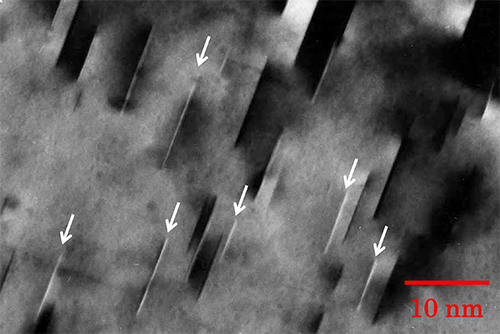GP zone
GP zone
"GP zone" means a plate that is composed of solute atoms segregated on a plane. The zone was discovered independently by A. Guinier and G. D. Preston through the analysis of streaks extending from X-ray Laue spots. It is named Guinier-Preston (GP) Zone after the two researchers. In the case of an age-hardened alloy that consists of Al or Mg but includes minute solute atoms (Cu, etc.), when its super-saturated solid solution is rapidly cooled and undergoes an aging treatment at a low temperature, solute atoms (Cu, etc.) are precipitated as one or two atomic planes with lattice matching on the {001} plane of the parent phase. It is noted that they do not appear as precipitates in the equilibrium state. The GP zone causes age hardening of alloys containing Al or Mg. In a bright-field image, the GP zone shows a line contrast due to lattice distortions. In a high-resolution image, the arrangement of solute atoms is directly observed.

Bright-field image of an AlCu alloy containing GP zones taken at an accelerating voltage of 100 kV.
GP zones (Cu precipitates) are seen to be bright (white) lines, indicated by white allows, because they do not satisfy Bragg condition.

Bright-field image of an AlCu alloy containing GP zones taken at an accelerating voltage of 100 kV.
GP zones (Cu precipitates) are seen to be bright (white) lines, indicated by white allows, because they do not satisfy Bragg condition.
Term(s) with "GP zone" in the description
Are you a medical professional or personnel engaged in medical care?
No
Please be reminded that these pages are not intended to provide the general public with information about the products.




